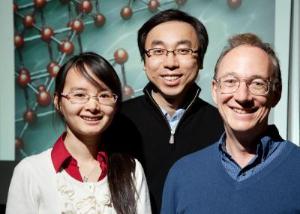
CHAMPAIGN, Ill. - University of Illinois materials scientists have developed a simple, generalizable technique to fabricate complex structures that assemble themselves.
Their advance, published in the Jan. 20 issue of Nature, utilizes a new class of self-assembling materials that they developed. The team demonstrated that they can produce a large, complex structure - an intricate lattice - from tiny colloidal particles called triblock Janus spheres.
"This is a big step forward in showing how to make non-trivial, non-obvious structures from a very simple thing," said Steve Granick, Founder Professor of Engineering at the University of Illinois and a professor of materials science and engineering, chemistry, and physics. "People know a lot about how to do it with molecules - soaps for example - but scientists and engineers know very little about how to make it happen with particles. Particles are very different from molecules: They're big, they're nonflexible, and they have lots of critically different materials properties."
Much of the work to date in making complicated structures from colloidal particles has been done through computer simulation. Researchers model complicated designs built of highly complicated particles.
However, creating complicated building blocks for experimental use is difficult. By contrast, the triblock Janus spheres' elegant simplicity makes them ideal for real-world manufacture.
"It was conceptually challenging to fabricate a complex porous material from a simple design, especially in the field of colloidal particles," said graduate student Qian Chen, a co-author of the paper. "Here, we achieve that with really easy designs that we can use in experiments."
Granick's group is well-known for its work with Janus particles. Named for the dual-natured Roman god, Janus particles have two sides or segments of different surface chemistry. Having explored spheres with two different-natured halves, Chen had the idea to make spheres with three "stripes" of reactivity, dubbed triblock Janus spheres. The center band is charged, while the poles are hydrophobic, or water-adverse.
"After many experiments with Janus particles, I wanted to see if adding one more segment would introduce more surprises," Chen said. "Usually in colloid science people use particles that have a uniform surface chemistry. But for this particle, it's like a block polymer. It has three segments of chemistry."
In a salt-water solution, the hydrophobic poles are drawn together, while the charged equators repel one another. As a result, the spheres form a complex lattice where only the poles are in contact with one another. The hydrophobic polar caps are large enough to come into contact with two other spheres. This causes the spheres to arrange into a formation like a six-pointed star, creating a sheet of delicate lace.
Such porous sheets of schizoid particles, hydrophobic and hydrophilic at the same time, could have applications as specialized filters.
"It's like a better soap," Granick said. "Just as soap is very good at dissolving both fats and water-soluble things, our new lacy lattice can also filter out both water-soluble and oil-soluble matter. We have this wonderful self-produced lacy structure that's oil-loving and water-loving at different parts in a periodic array."
The team could apply their simple particle design to fabricate other planar laces. Adjusting the size of the spheres or the proportion of the bands could lead to other lattice patterns or tuned pore sizes. In addition, further exploration of triblock spheres and other Janus particles could open doors to a broad area of self-assembly of complex structures from simple materials.
"Someday maybe we could have a soup of different components, remove some of it, and there would be a microelectronic chip," Granick said. "It's a brand new area. The materials are so different that the structures that they form will be different."
Research scientist Sung Chul Bae also was a co-author of the paper. The U.S. Department of Energy sponsored this work through the Frederick Seitz Materials Research Laboratory at the U. of I.
Further Information:
Qian Chen,Sung Chul Bae and Steve Granick:
Directed self-assembly of a colloidal kagome lattice.
In: Nature; 469, 381-384, 20 January 2011, DOI 10.1038/nature09713
Source: University of Illinois at Urbana-Champaign, USA
Last update: 20.01.2011.
Perma link: https://www.internetchemistry.com/news/2011/jan11/triblock-janus-spheres.php
© 1996 - 2023 Internetchemistry